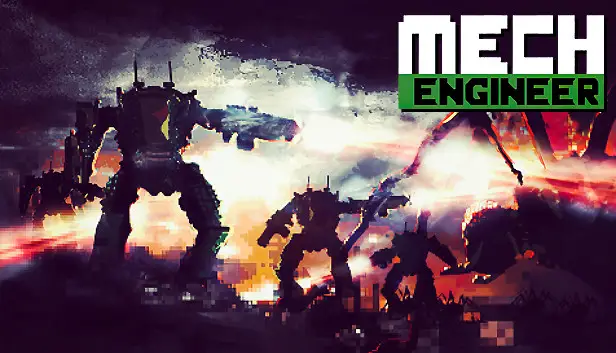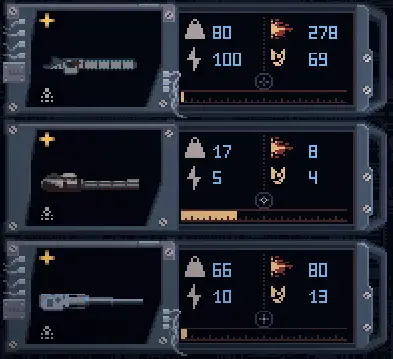This guide will help you understand the extra slots you can use in the game Mech Engineer, along with their purposes and potential issues.
Auxiliary Modules Overview
People might not pay much attention to auxiliary modules in Mech Engineer, and they might be confusing for new players. These modules change how your mech works to fix problems or add new features. Each mech has different auxiliary slots—some have lots, and some have only a few. Your task is to figure out how to use them best with your design.
Here’s a breakdown of the modules and what they do:
Ammo Module: This makes your mech carry more ammo and improves control by 1.
Battery Module: It gives your mech 15% more energy based on its reactor output. Bigger reactors benefit more.
Evasion Module: This module boosts evasion by 25% and helps your mech regenerate stability faster. Good for rough terrain or melee builds.
Turbine Module: Adiciona 3 weight to your mech, drains 3 energia, but grants 15 water resistance, 2 oxygen, e +35% underwater speed. Useful for underwater battles.
Metal Grid Module: Dá +10% maximum hit points for your mech and safety for the pilot. It also reduces the base weight by 10%.
Torpedos Module: Guides explosive weapons underwater, handy for submerged combat.
Capacitor Module: Reduces heat from shots by 25%.
Heat Sink Module: Increases cooling power by 4%, but adds 3 extra weight to your mech.
Armor Module: Fornece +1 armadura e 15 impact resistance but increases mech weight by 1.
Repair Drone Module: Allows pilots with the Drone repair perk to fix nearby mechs during a fight.
Shield Module: Boosts shield power by 5% and damages enemies on contact based on shield power.
C-RAM Module: Offers point defense, shooting down enemy missiles. Needs ammo and reloads after use.
Needle Bullets Module: Lets your mech fire kinetic projectiles like bullets underwater without speed and range penalties.
Deciding when to use specific auxiliary modules in mech design is crucial. Before adding any module, it’s vital to understand the purpose and overall design of your mech. A well-chosen auxiliary module can transform a subpar design into a perfect one. As you unlock newer mech designs, the number of auxiliary slots may decrease, reducing your options. Portanto, careful consideration is necessary to maintain a balanced design.
Example Scenarios
One cool example is when a mech has a problem with getting too hot. This heat issue could be from the environment or shooting a lot. Instead of using one of the precious extra slots to fix it, primeiro, think about the design of the reactor, where the mech is, and what weapons it has. Sometimes changing the reactor design can help, or you might want to switch the weapons. Heat sinks and capacitors are specific tools for this.
Por exemplo, if your reactor is all about reducing heat from shooting, you might want to use heat sinks for the environment heat or extra capacitors for heavy shot heat. Heat sinks and capacitors help your mech last longer in a fight. If your mech keeps shutting down to cool off, it becomes an easy target. Pilots can get perks to help, and overclocking cooling might do something, but the vulnerability problem still stays. The point is, extra slots won’t fix everything, just make it a bit better. Sometimes you get lucky with the design and things work out.
Another example is when you need a special module for things like underwater fights. Not all mechs are made for underwater battles, but with special modules, even a non-aquatic mech can work underwater. Turbine modules are a must for moving and staying alive underwater. Depending on the weapons you have, you might need needle bullets or torpedo modules. Even underwater mechs might need those depending on their weapons. Just because a mech can swim doesn’t mean its weapons are made for water!
Battery modules are a common thing in mech designs, especially with energy weapons. The more power your reactor makes, the more useful battery modules are. Enquanto você joga, you might find energy weapons or systems that need more power. Então, keep in mind that bigger weapons might need extra power.
Some mechs are better suited for support rather than being at the front lines. If your mech has many extra slots, it’s great for this role. Support mechs don’t focus on dealing damage; em vez de, they use modules like C-RAM, repair drone modules, and shield modules to help and protect other nearby mechs. These mechs are not meant to be heavy hitters but are more about handling weaker enemies, allowing other mechs to unleash powerful attacks on specific tough enemies or bosses.
Words of Wisdom
Finding the right balance between making a mech functional and ensuring its long-term use can be tricky. Juggling different environments and adjusting mechs for combat situations or team gaps can feel overwhelming. In such situations, it can be helpful to equip a few mechs in your assault team with support modules instead of dedicating a mech solely for that purpose. This spreads out support across your team, ensuring redundancy in case one mech goes down. Having backup is a good strategy!
During the rush of production when outfitting a mech, a well-placed auxiliary module can make a significant difference in getting a design to work until production catches up with your needs. Before dismissing certain modules in favor of more common ones, consider their potential use. Por exemplo, evasion modules are helpful early in the game for navigating challenging terrain with early mechs. When facing new enemies, boosting the survival of your mechs with armor or metal grid modules can be a wise precaution.
Ammo modules are excellent if used wisely. Por exemplo, treating miniguns as a “if it sits, it fits” type of weapon can be a smart approach. Just because you unlocked a new laser doesn’t mean you should completely switch to the new weapon system. Each weapon system has its creative uses, and when paired with ammo modules, kinetic weapon systems like cannons, miniguns, and railguns can significantly increase damage potential.
When designing a mech, don’t focus only on flat damage. Consider sustained damage and longevity as crucial factors for success in battles. It’s not just about hitting hard; it’s about lasting through the fight and dealing damage consistently.
What to Avoid to Screw Up Your Design
Ammo modules aren’t limited to just kinetic weapons like miniguns, canhões, and railguns; they benefit any weapon that uses ammo. This includes missiles, plasma, and even chemical weapons. It’s crucial to pay attention to the module description and its potential applications for different weapon types. Always be mindful of how a module can enhance the performance of various weapons in your mech arsenal.
I don’t use these modules, and I think they’re useless.
INCORRECT! Even if you don’t find some modules helpful at first, they give you options. Some players might skip evasion, armadura, or metal grid modules, preferring other choices. But that doesn’t mean it’s the best decision. Mech Engineer is tough and won’t guide you gently. It wants to challenge you and expose your poor design choices.
Even with auxiliary modules, my design doesn’t work.
Entendo; I’ve been there. It can be tough. Às vezes, it’s best to start over and redesign your mech. It might feel frustrating to go back to square one, but it’s often for the better. Don’t stress about optimizing your weapon systems perfectly; they don’t have to be flawless. Understand your mech’s limitations and build around them. Design from the ground up, não o contrário.
Not enough auxiliary slots!
I feel you! But making your design work with limited slots is part of the challenge. Think of auxiliary slots as a bonus, not the core design. Design your mechs with this in mind, and you’ll find the slots more flexible than before.
I always end up using heat sinks and capacitors!
Seems like a personal issue… Seriamente, Eu entendo. The temptation of an all-energy build or pushing a weapon system to its limits is strong. No entanto, it’s not always the best choice. When designing your mech, give yourself some wiggle room with heat. Heat-related modules are meant to offset heat, not solve it entirely. No entanto, it’s a great feeling when adding a heat sink resolves your heat issues.
My mechs act weird in swamps and deserts!
Evasion modules! The stability bonus is crucial. Designing mechs for challenging terrain might be tedious, but it pays off. Consider your environment, especially if you might face contaminated areas, tough bosses, or new enemies.
The bugs started charging and shooting back at me!
Sim, they do that sometimes. Armor and metal grid modules, especially armor, can help mitigate damage. Charging bugs can damage a mech’s armor, so adding an auxiliary module can be beneficial in the early game when armor is limited.
My pilot drowned, and now I’m sad.
Turbines and metal grid modules can help. Extra safety and oxygen provide your pilot with more protection before their hull breaches, preventing implosion or drowning.
My drones aren’t repairing my mechs; what gives?!
Your pilot needs the drone perk to use the drone. Don’t confuse it with the commander perk, which boosts but doesn’t allow drone use.
C-RAM doesn’t do much…
C-RAM is excellent; more is better. If you face enemies launching missiles, outfitting your team with C-RAM is wise to avoid repair costs or potential mech loss. Some bosses also use missiles, então tenha isso em mente.
The energy shield module seems like a waste of space.
Yes and no, it’s a niche module. It’s useful when navigating caves or enemy bases, protecting your mechs from swarms without melee capabilities. Think of it as a giant bug zapper.
Isso é tudo o que estamos compartilhando hoje para isso Mech Engineer guia. Este guia foi originalmente criado e escrito por Einhander. Caso não atualizemos este guia, você pode encontrar a atualização mais recente seguindo este link.














